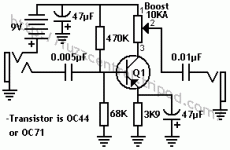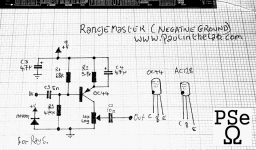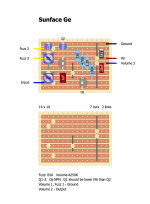MBFX
Well-known member
EDIT: THE SOLUTION IS TO UNDERSTAND THE DIFFERENCE BETWEEN POWER AND GROUND VS. POSITIVE AND NEGATIVE POLARITY. IF YOU THINK IN POLARITY, YOU'RE FUCKED AND YOUR PEDAL WON'T WORK.
The way to edit the veroboard layout below is to flip the electrolytic capacitors around. Remove the diode, because it's the wrong way in the vero layout as posted and it's better to have it on the barrel connector. Connect the power rail (labeled 9V) to the sleeve of your barrel connector. Connect the ground rail to the tip. From there, you're going to want to plug it in - make sure you are using a "backwards" power cable, such as this:
You can make one, but I've had a hard time finding DC connectors small enough to be worth it.
-----------------------------------------------------------------------------------------------------
Original post:
The following PNP Germanium transistor using circuit references negative voltage. I want it to reference positive voltage, so it can be in the same box as a positive reference voltage Germanium Fuzz Face, using a shared Lumberg power connector. No battery. I am too inexperienced to simply walk into Mordor.
I look at the schematic, and I can understand the difference. On a breadboard, I understand the difference. I look at this vero layout, and my brain short circuits. What is the actual difference here? I don't understand how I would change it to make the positive rail Vref.
VERO LAYOUT I USED, PRETEND THE DIODE ISN'T THERE:
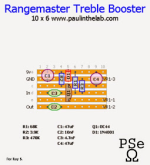
SCHEMATIC FOR ABOVE, PRETEND THE DIODE/OTHER WEIRD THINGS AREN'T THERE:
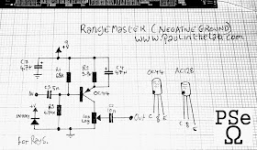
The way to edit the veroboard layout below is to flip the electrolytic capacitors around. Remove the diode, because it's the wrong way in the vero layout as posted and it's better to have it on the barrel connector. Connect the power rail (labeled 9V) to the sleeve of your barrel connector. Connect the ground rail to the tip. From there, you're going to want to plug it in - make sure you are using a "backwards" power cable, such as this:
You can make one, but I've had a hard time finding DC connectors small enough to be worth it.
-----------------------------------------------------------------------------------------------------
Original post:
The following PNP Germanium transistor using circuit references negative voltage. I want it to reference positive voltage, so it can be in the same box as a positive reference voltage Germanium Fuzz Face, using a shared Lumberg power connector. No battery. I am too inexperienced to simply walk into Mordor.
I look at the schematic, and I can understand the difference. On a breadboard, I understand the difference. I look at this vero layout, and my brain short circuits. What is the actual difference here? I don't understand how I would change it to make the positive rail Vref.
VERO LAYOUT I USED, PRETEND THE DIODE ISN'T THERE:

SCHEMATIC FOR ABOVE, PRETEND THE DIODE/OTHER WEIRD THINGS AREN'T THERE:

Last edited:


